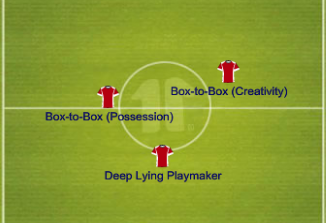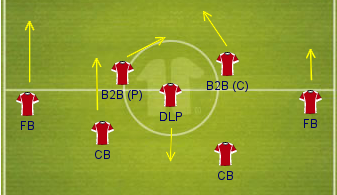The midfield is the heart of the team. It’s the area where football matches are won and lost. This particular area works as the dynamic unit that allows a team to shift from a defensive phase to an attacking phase. It’s the creative territory of the field. The men in midfield are required to assist the defence in preventing attacking plays from the opposition, picking up the loose balls out of defence and quickly converting them into attack. That is the basic aspect of a midfielder’s role when analysed in a conventional sense. To understand better how the transition occurs, the precise duties executed by them and various supporting roles represented, we will have to look at the midfield more comprehensively.
The Trio
- Deep Lying Playmaker
- Box-to-Box (Required to win back possession)
- Box-to-Box (More creative of the box-to-box midfielders)
Defensive play
As explained in the previous part, the full backs have significant attacking roles, while the central defenders also take any opportunity to get forward. When this is done, its crucial for the midfield to cover for the attacking players. The deep lying playmaker will therefore drop back into the defence and pocket himself just ahead of the defenders. He will also on occasions, sit next to the central defenders assuming the other’s role. So when a transition is being made from defence to attack, the team moves up as a unit, while the deep lying playmaker does the reverse. This is the cover applied while in an attacking phase.
All attacks obviously don’t prove to be fruitful. With the numbers being committed in attack, gaps are left at the back. Especially in the wide areas, which is primarily covered by the full backs without cover behind them or support ahead. Opposition is able to exploit the flanks due to this commitment to the attacking play. Quick counter attacks are usually what completely catch attacking teams out. Here is where the deep lying playmaker has a vital role to diminish the attack of the opposition, put an end to the counter attack or at least keep it under control. Its important that he reduces the force of the attack, delaying it and giving his teammates valuable time to recover into position.
With the full back committed forward, it leaves the opposition with space out wide to exploit (the box displayed). The Deep Lying Playmaker will have to cover that area to prevent an attack and contain the opposition.
So the Deep Lying Playmaker has the basic duty of covering the middle area in the centre and and both flanks. This has to be done in more defensive sense, that is usually in one’s own half. This is where this midfielder is primarily employed. When faced against an attack, this player is required to take a more protective role, mostly deployed around the box and not requiring to go too far ahead from this area. They are ball winners as well but this is more relevant to open play where the ball is being played in the middle of the park and the team isn’t pushed back. No one has definite control and there is no decisive phase of play.
When the team is pegged back into a defensive phase, it is important that they remain organised. The midfield should maintain a compact line. Preventing through balls into the box while picking up the loose balls and quickly converting it into an attack. As mentioned the DLP will not leave his position much in this play, but the Box-to-Box Midfielders have a crucial role here, especially the ball-winning box-to-box midfielder i.e. the one entrusted with regaining possession. These midfielders are the ones who leave their sanctuary around the box and try to break up the oppositions play when they have control.
The DLP stays back around the box to win back the ball and lay it off to the B2B midfielders. These midfielders also attempt to move forward and press the opposition, winning the ball back and either playing it forward or taking it forward.
Box-to-box midfielders are required to both attack and defend. So they’re constantly required to move back, transitioning from an attacking play to a defensive play by tracking back and vice versa. They are at the same time required to mark the opposition players, occupying the midfield, covering the space and not giving them time on the ball. They need to press the opposition; allowing the opposition midfielder/attacker as little time as possible on the ball. Closing down in an attempt to win the ball back and regain possession is where they earn their money. For example, many fans have complaints about Henderson’s performance. It is justified, but his off the ball movement in a defensive phase is exactly how Rodgers will set out his midfielders. Constant pressing combining with the other players. The attempt here is to ensure there are at least two players pressing the opposition man on the ball. Considering that the midfield forms a midway point in the team, whether the possession is in the opponent’s half or not, one of the two pressing players will be a midfielder.
This illustration shows the work rate the midfielders have to give in pressing and closing down opponents while being assisted by strikers/full backs i.e. depending on the position of the player with the ball. Keeping in tune with the two men on player in possession rule.
In addition to closing down opponents on the ball, the midfielders are also required to close down players who the player in possession may attempt to pass the ball to i.e. covering the passing options as well.
Attacking Play
In route one football the defence directly supplies a long ball into the attacking zone, hoping for a chance to fashion itself through a knock on or the midfielders to pick up the second ball. However in a Rodgers’ 4-3-3 system, the ball is largely played along the floor in short passes and quick touches. The defence on occasions attempt to directly get the ball into a more attacking zone, along the ground. But the midfield largely assume the role of playing the middle men. They link the defence with the attack. So in this system, as opposed to a route one style, a lot of hard work is needed in the middle of the park, and the game is largely played here.
The creativity in any teams dwells primarily in the midfield. It’s no different in a 4-3-3 either. Obviously the defence have some level of contribution as well. But the creative duty largely lies with the midfielders.
Firstly, the deep lying playmaker has the liberty of more time on the ball. This allows him to read the game and study the field ahead of him more comprehensively. He can then pick out an accurate pass. It’s highly important that this player has the intelligence to take advantage of this freedom. This player is the one that provides some respite, acting as the breakeven point of the team. When he has the ball at his feet, the remaining team are able to get into effective positions. This movement is essential in creating options for the DLP. He is also entrusted with the duty of shifting and rotating play around: the fulcrum of the midfield. He will see a lot of the ball and is required to have good on the ball skills coupled with patience in regards to rotating the play. He needs to be calm and composed. As many would have noticed with Lucas, he is constantly coming back to receive the ball from the defence, when they fail to see any opening. The midfielders higher up also look to pass the ball back to the DLP when they fail to fashion out a chance, again allowing the team to rotate their positions until a proper pass can be made. This player however will rarely move forward with the ball or find his way into the midst of an attacking territory. His position is such that it gives him an entire overview of the field ahead of him. He can see the entire attacking area. He overlooks all the attacking players from his fellow midfielders, to the forward moving full backs and the strikers.
The box-to-box midfielders work more tirelessly. They are far more immersed in the attacking zones. But as mentioned one of them plays a possession winning game and one is more creative. It should be noted that despite this both are expected to attack and defend. The intensity of creativity and ball winning is what differs. It is due to this that one of the box-to-box midfielders is more defensive and the other more attacking. The attacking one goes further forward and makes later runs into the box while also hanging around the box to play that killer pass. When one of them (box-to-box midfielder) goes forward the other covers the area behind him.
As seen here, when one B2B is forward, the other is behind him covering the area. Either to pick up lose balls and put circulate it back, or provide passing options. This covering also helps on the defensive front.
Movement among all three midfielders is key in this system. While the Deep Lying Playmaker moves around in his territory (explained above) the Box-to-Box midfielders are required to constantly move in the attacking half. They need to take complete control of this zone. Moving around, tiring down the opposition, forcing a mistake. The forwards should be able to receive the ball comfortably while also be able to displace the ball from their feet when no attacking avenue can be taken. The midfielders are vital for this purpose.
As already touched upon, getting into the box will be crucial this season. Last season we were faced with issues where our midfielders were reluctant to get into the box. When the ball is switched wide, there will be only one or two players in the box, the midfielders will be needed to run in and provide further support. They will also be required to take position outside the area in case of any ball that is cleared. What happened constantly last season was that, midfielders weren’t around the box often, so when a ball was cleared, the opposition had space to run into and play a good ball to a teammate. This made us extremely vulnerable at the back when we attacked. This is where playing the pressing game off the ball and during an attack applies and will help.
The midfielders possibly could be given duties out wide as well, taking some off the load of the back of full backs. In such a case the midfielders would go wide and put crosses into the box. However the use of crosses will not be prominent in the system. Also, midfielders shifting wide would put us short in the center of the pitch.
Liverpool Application
The midfield needs proper understanding and training to really be able to adjust and play to the system. The only real Deep Lying Playmaker present in the team is our Brazilian Lucas Leiva. After years of torment, he has developed into one of the best to play this role. He is absolutely vital to the team and is probably the first name on the team sheet. His general play suits Liverpool perfectly. He will have no trouble into fitting with the movement, quick touches, short passes and intelligence. He is also vital for applying the transition phase both from defence to attack and vice versa. Jay Spearing at the moment appears to be the direct back-up to Lucas and the DLP position. But whilst his work rate and determination cannot be questioned, his general ability is very average. His position is the same but his role is completely different. Spearing is a defensive midfielder which is different to a deep lying playmaker.
Calls have been made that due to age not being on his side, Gerrard should be played in a deeper role. While this could be a good move, Gerrard would not make a good deep lying playmaker. His vision would be better suited higher up the pitch. In the past few seasons the number of forward runs made by our captain has reduced. But to convince Gerrard to stay deep, as deep as a DLP would require would be unwise. He made his name in the attacking zone and that is where he would naturally want to play. The issue here is that since this role would be a box-to-box midfielders role, probably the creative one, he would require a high work rate. He should be able to move into attack and defence constantly. This maybe asking too much of our captain. However, it is critical to keep the balance of the team. Gerrard will take some time to fit into a 4-3-3 system. There is a possibility that Rodgers employs Gerrard in a more attacking zone, out wide in the final third. That remains to be seen and will be explained and analysed in the next part of this series. But his ability is such that not too many can question his capacity to do just that.
Joe Allen is someone that has worked closely with Rodgers. He has been able to understand his role in the system perfectly as taught by Rodgers and he is a prime example of a box-to-box midfielder. To better grasp the knowledge of the box-to-box midfielders role, one should focus on the play of Allen. The fact that he has plied his trade largely in the second division of English football is no indicator of his true ability. He is a quality player and indeed still a bit underrated. Rodgers insisted on signing Allen, as the season progresses the fans will understand his importance.
Nuri Sahin is a player who has constantly been linked with Liverpool throughout the summer, and we now appear to have beaten Arsenal to his signing. One can clearly infer the need to sign Sahin. Rodgers’ plan will be to employ Sahin as the creative box-to-box midfielder as explained above. Sahin is known for his ability to create and score from midfield. He would be ideally suited for this role. A role which he mastered in the Bundesliga with Borrussia Dortmund. It’s his signing that could see Gerrard move into a role in the final third.
Another midfielder who has been somewhat undervalued is Jonjo Shelvey. His play is typical of a box-to-box midfielder. Of all the midfielders last season, Jonjo was the most determined to get into attacking areas and he did a good job of it as well. Henderson is someone who is willing to press his opponent and he is able to shift the play in less dangerous zones. He is young and if trained properly, he would do a good job fitting into the side, providing cover. He would especially be crucial with 20 minutes or so left in the game while we are trying to maintain control. Charlie Adam is someone who has raised alot of questions among the Anfield faithful. The dilemma here is that he would not be able to pull off a DLP role convincingly while his lack of fitness would put a dent on his box-to-box chances as well. It remains to be seen what the future holds for Charlie in Rodgers’ plans.
Final Note
So the midfield plays a crucial part in linking the entire team together whilst also playing a central part in the transition play. It is critical that the midfield battle is won by the side. This would go a long way in controlling the game and dictating the play. For this system to work effectively, for the 4-3-3 to be applied all round, it is of immense importance that the midfield trio understand their roles accurately and apply them effectively. Any football enthusiast would love to see this type of system being displayed in midfield and if given time, Rodgers will definitely be able to apply this effectively. The play of a DLP and B2B is beautiful to watch. It will be absolutely delightful to watch a Liverpool midfield in this system.
This article was written for www.lfcts.com
All illustrations were made at www.this11.com


































































